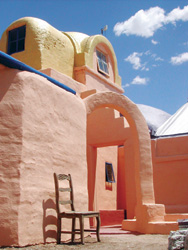A House Made From Paper
Forget the old saying that people who live in glass houses shouldn’t throw stones. Now you can live in a paper house that’s so strong stones won’t make a dent.

Ask Kate Thayer and Clyde Curry of Marathon, Texas about the advantages of building with recycled paper. For the past four years they have been testing and building with various forms of papercrete, manageable-sized bricks made of recycled paper products and Portland cement. “We didn’t invent the idea of mixing paper and concrete,” says Curry. “We’re just experimenting with how to use it.”
At Eve’s Garden Organic Bed and Breakfast and Ecology Resource Center in Marathon, Thayer and Curry showcase classical architectural designs made from paper. Aesthetically pleasing domed designs curve gracefully, forming rounded openings and high ceilings, many painted in brilliant hues of purple, orange and turquoise.
A Growing Field
With readily available raw materials and short construction times, interest is growing in the concept of turning trash paper and cardboard into inexpensive houses that are strong, well insulated and easily built. “It’s a simple method of construction,” says Curry.
Remember making papier mã{99}
é out of shredded newspapers in grammar school art classes? That’s essentially what papercrete is: an ideal cheap building material utilizing unwanted newspapers, magazines, cardboard, and junk mail—plus local sand and dirt. Curry uses mortar as a surface-bonding agent on drystacked bricks to produce safe, structurally sound buildings.
Papercrete provides strength without the weight of concrete (it’s 80 percent air), making it an ideal material for building arches, domes and vaulted ceilings. The material eliminates the need for expensive and often insufficiently insulated roof systems and requires less mechanical construction.
Construction costs with papercrete (other versions are called padobe or paper block) are estimated at 20 to 30 percent less than conventional housing. Sean Sands built his ecologically responsible home in Columbus, New Mexico with $500 in materials. Papercrete structures also require only 50 percent of the energy needed to heat and cool conventional buildings.
Eric Patterson, who built a papercrete home in Silver City, New Mexico, adds another benefit. “This phenomenal insulation also deadens sound,” he says. Although long-term performance results are still being evaluated, Patterson has lived in his papercrete home for more than 11 years. “I built my house with a conventional look,” he says, “and people can’t tell the difference.”
Americans discard enough paper each year to build four 12-foot walls around the entire perimeter of the country, so using recycled paper for construction would save millions of trees and 40 percent of landfill space.
Papercrete advocate Barry Fuller worked with the Arizona Department of Environmental Quality to research sites in Texas, New Mexico, Arizona and Colorado, where structures have withstood a variety of climate conditions. He has written a technical paper based on that research and is producing a documentary on construction of a building with sensors connected to the Internet that allow anyone in the world access to real-time data about the structure.
Fuller’s Center for Alternative Building Studies in Tempe, Arizona is working to establish uniform standards, and he predicts that within a year several companies will be making paper blocks for commercial use. “The past six months have witnessed an explosion in the number of papercrete projects,” Fuller says. “I believe the ball is rolling and gaining speed.”
The Cardboard House
Another innovation, the Cardboard House, is the brainchild of architects at Australia’s University of Sydney. It’s a fully recyclable house with its own water collection and composting systems, plus autonomous power service from low-voltage batteries. Assembly requires 12 to 24 hours, and the house can be altered, repaired or reconfigured according to changing needs. Recycling the house is estimated to save 12 cubic meters of landfill and 39 trees.
Because cardboard is extremely low cost, lightweight and transportable, it could be ideal for temporary applications including vacation cottages, student dormitories or emergency housing after natural disasters. The DuraKit Instant House, for example, includes all the necessary components: a flat pack of frames, floor and wall panels, plus nylon wing nuts, polyester tape and Velcro fastenings that hold everything in place. While current designs may be marginally acceptable to U.S. consumers, the prototype may lead to other options for alternative housing.
Fuller predicts a growing market for papercrete construction. “Given the skyrocketing costs of building materials and construction, and the pressing need for homes, it is just a matter of time before waste paper will begin to take its place as an acceptable and even desirable residential construction material,” he says.
BEVERLY BURMEIER supports alternative building methods from Austin, Texas.

